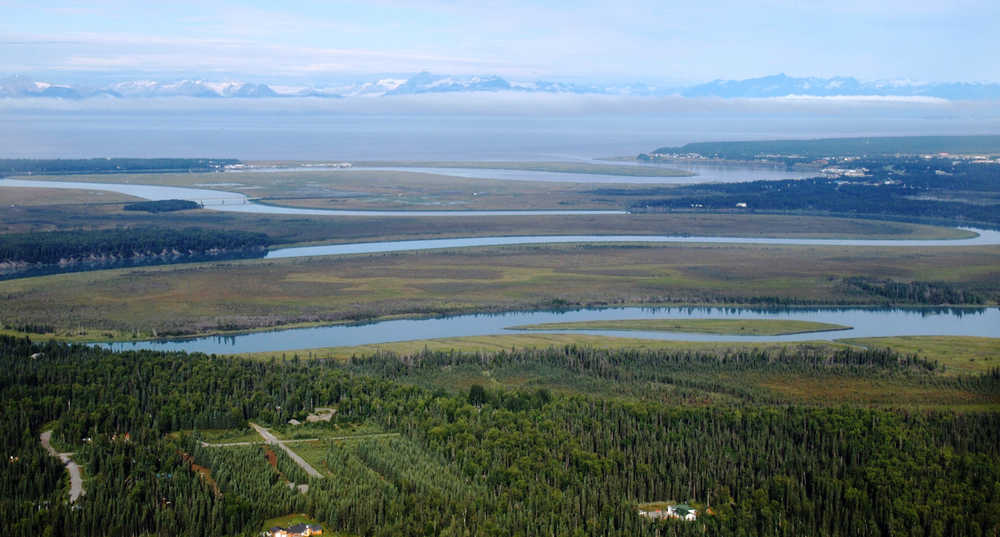My favorite place to birdwatch, or “bird,” on the Kenai Peninsula is the Kenai Flats. “The Flats” are not merely the wetlands you see from Bridge Access Road or from the bluff near the Kenai Senior Center. In its entirety, it encompasses 7,500 acres of intertidal mudflats, sand and gravel bars, dunes, tidal sloughs, creeks, river, grasslands, riparian shrub and forest. As the estuary of the Kenai River, the Flats extend a mile beyond its mouth into Cook Inlet and upstream to River Mile 12 near the Pillars.
By definition an estuary is the tidally influenced, broad lower course of a large river and embayment at its terminus where salt and fresh waters meet and mix. Here, nutrient-laden river waters combine with shallow coastal waters and the upwelling of nutrient-rich deeper ocean waters, generating exceptional primary productivity that supports vigorous marine food chains. They are areas of concentrated productivity, measured as abundance of individual organisms and species, as well as biomass and energy. The wealth of plant life and invertebrates directly or indirectly provide nourishment for resident and migratory fish, marine mammals, and birds. Estuaries are renowned for their prodigious biological productivity and, along with tropical rainforests and coral reefs, rank as the world’s most productive ecosystems.
Accordingly, a few local biologists and a handful of dedicated birders from the Keen Eye Bird Club decided it was finally time to formally assess the avian productivity of the Kenai River estuary. Combing through thousands of records of bird sightings over the last 50 years, a checklist of species and their relative abundances through the four seasons was compiled. The effort delineated 187 bird species that have been seen on the Flats, of which a remarkable 81 species are known to breed there annually or at least occasionally.
The “Checklist of the Birds of the Kenai Flats” serves as the most current and complete inventory of bird species for this area. It is long overdue considering the Flats is one of the foremost bird watching destinations on the Kenai Peninsula. Two other local birding “Meccas,” Kachemak and Resurrection bays, have had formal bird checklists for decades. The new checklist proves that the Flats deserve its weighty reputation — though considerably smaller in size than the other two areas, the number of bird species documented on the Flats rivals them.
While the checklist is a compilation of all species recorded over five decades, the relative abundance is essentially a snapshot in time (2014). This latter attribute is invaluable to biologists. Bird populations are dynamic, so periodic snapshots allow biologists to track changes in abundance (and occasionally species) over time.
For example, Rusty Blackbirds and Red-necked Phalaropes were once common breeders and migrants on the Kenai Flats but have become increasingly scarce, reflecting not merely local but continent-wide declines. Conversely, Northern Saw-whet Owls, Red-breasted Nuthatches, and Brown Creepers, now common in the Flat’s riparian forests, were not known to occur there prior to 1970 before these species experienced dramatic continental expansions northward and westward.
Aleutian Terns commonly bred on the Flats decades ago but now only occasionally feed there in modest numbers. In contrast, Northwestern Crows and Steller’s Jays first appeared on the Flats little more than a decade ago but now breed along its wooded margins. The colony of hybrid Herring Gull-Glaucous-winged Gulls has grown substantially, their status changing from common to (super) abundant, likely due to increasing local food sources (especially from human waste). Bald Eagles are also far more numerous on the Flats, benefiting from the same waste sources, opportunity to prey on the colossal gull colony, and the end of the Bald Eagle bounty in 1952.
I would be remiss if I did not discuss the dramatic decline of Snow Geese on the Kenai Flats. In years past, 10,000 Snow Geese could be seen during peak staging in late April. But over the past ten years you’d be fortunate to see even 300 at their peak. This does not reflect a continental or flyway-wide decline as their populations are robust, but rather their abandonment of the Flats for estuaries on the west side of Cook Inlet.
Species that typically garner disproportionate attention on checklists are the one-time rarities such as the Ruff in 2003, Ivory Gull in 2006, and Lesser Black-backed Gull and Willet in 2012. Notably, the Willet sighting was the first and only substantiated record of this species in Alaska. Avid birders from all over the state converged on the Flats to view this mega-rarity.
“Checklist of the Birds of the Kenai Flats” should be available soon at the Kenai and Soldotna visitor centers, as well as the Kenai Refuge headquarters. Also, contact the Kenai Refuge (262-7021) or the Keen Eye Bird Club (262-7767) if you’re interested in counting birds during the fifth annual BIG SIT on Saturday, October 11 from 8 a.m. to 6 p.m. at the Lower Skilak Lake Boat Launch Campground.
Toby Burke is a Biological Technician at the Kenai National Wildlife Refuge. You can find more information about the Refuge at http://kenai.fws.gov or http://www.facebook.com/kenainationalwildliferefuge.

